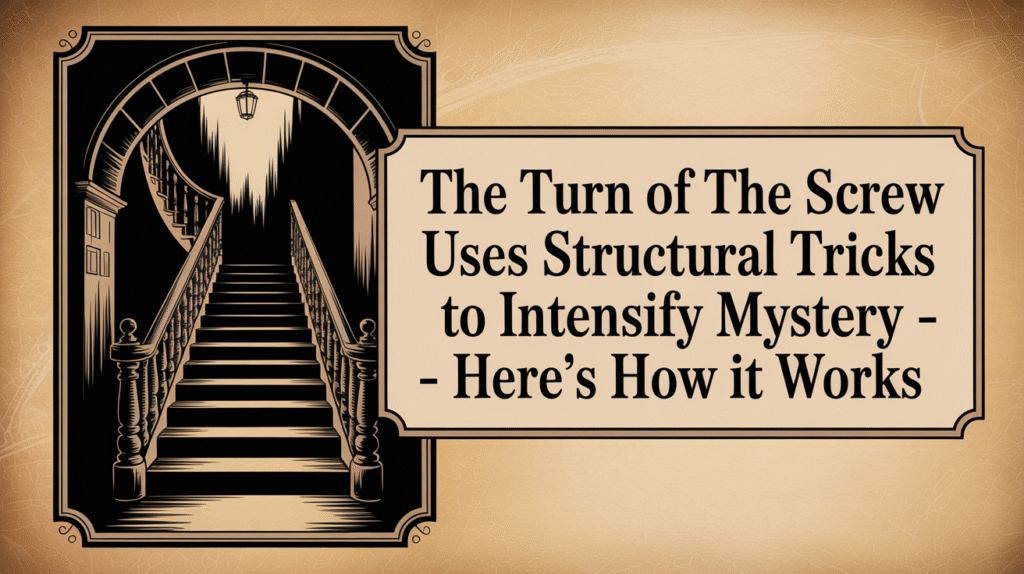The Turn of the Screw doesn’t just rely on plot and characters to create suspense, it uses its very structure to destabilize the reader and heighten ambiguity.

Henry James crafts a story that bends time, layers narratives, and avoids traditional resolution to create an immersive psychological experience. This article explores how structural surprises and timeline manipulation help turn a simple ghost story into a literary puzzle.
The Framing Device Adds Distance and Uncertainty
The novella begins not with the governess’s tale but with a frame narrative, a group of people telling ghost stories by a fire.
Why the Frame Is Crucial
This outer narrative layer shapes how we interpret everything that follows.
- We hear the story through Douglas, who reads the governess’s manuscript aloud, meaning we’re reading a secondhand account.
- The distance between the events and the telling introduces immediate doubt, emphasizing subjectivity.
Narrative as Performance
The structure sets the stage for a ghost story but complicates belief.
- The anticipation built in the frame primes readers to expect horror.
- This self-awareness makes the story feel like a dramatic reenactment rather than a factual retelling.
The Manuscript Format Limits What We Know
The main story is presented as a manuscript written by the governess after the events took place.
The Past Is Filtered Through Memory
The retrospective format allows for selective memory and emotional interpretation.
- The governess may be rewriting history to suit her own view of events.
- Time gaps and omissions in the manuscript introduce cracks in the timeline.
A Single Perspective Reigns
No other characters provide written or verbal counter-narratives.
- We don’t hear directly from Miles, Flora, or Mrs. Grose.
- The governess’s control over the structure mirrors her desire to control the story and the children.
Nonlinear Suspense Builds Psychological Tension
While the story appears linear, the emotional journey doesn’t follow a straight path.
Cycles of Calm and Crisis
The narrative loops through periods of calm, followed by increasing tension.
- Peaceful scenes are constantly interrupted by supernatural encounters.
- This rhythm creates an unstable emotional structure, keeping readers uneasy.
Sudden Shifts in Focus
The governess changes direction mid-scene or skips key details.
- One moment she’s caring and hopeful, the next she’s frantic and accusatory.
- These sharp tonal shifts break the narrative flow in unsettling ways.
Time Manipulation Intensifies Mystery
James carefully distorts the timeline to keep the reader guessing.
Ambiguous Time Gaps
There are no clear markers for how much time passes between events.
- Days and weeks seem to blur together.
- This foggy timeline mirrors the governess’s increasingly blurred sense of reality.
Climax Without Closure
The final scene happens quickly and leaves major questions unresolved.
- Miles dies suddenly, but the cause remains unclear.
- The story ends immediately, leaving readers without closure or explanation.
Lack of Resolution Is a Deliberate Structure
James ends the novella without explaining what really happened, structurally defying narrative convention.
No Final Reveal
There is no twist or resolution to clarify whether the ghosts were real.
- This absence of clarity makes the story linger in the reader’s mind.
- The structure reinforces the theme of uncertainty and repression.
Emotional Payoff Without Plot Payoff
The ending is emotionally charged but factually ambiguous.
- Readers feel the weight of loss and confusion but don’t get answers.
- It reflects the structure of trauma, felt deeply but not always understood.
FAQs About Structural Surprises in The Turn of the Screw
Here are some questions and answers about the structure and timeline tricks in The Turn of the Screw:
Why does Henry James use a frame narrative?
The frame narrative adds distance and makes the story feel like a ghost tale passed down through time. It emphasizes subjectivity and invites skepticism.
How does the manuscript format affect reliability?
The manuscript is a personal account written after the fact, which makes it prone to memory distortion, emotional filtering, and unreliability.
Is the story told in chronological order?
Mostly, but the timeline is foggy and lacks clear markers. Emotional tone often takes precedence over clear sequencing.
Why does the story end so abruptly?
The abrupt ending is intentional, it avoids closure to maintain ambiguity and thematic depth. The lack of explanation invites endless interpretation.
What’s the effect of structural ambiguity on the reader?
It forces the reader to become an active participant, constantly interpreting and reinterpreting. This enhances the psychological tension and makes the story unforgettable.
The structure of The Turn of the Screw is one of its most powerful tools. Through layers of narration, unclear timelines, and a refusal to offer resolution, Henry James creates a story that is as much about the act of storytelling as it is about ghosts. The structure invites suspicion, demands attention, and ensures that the novella’s mystery never fully dissolves, even after the final line.
